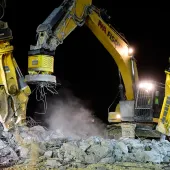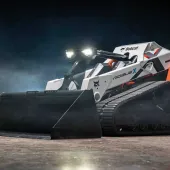Creating the best match of carriers and attachments
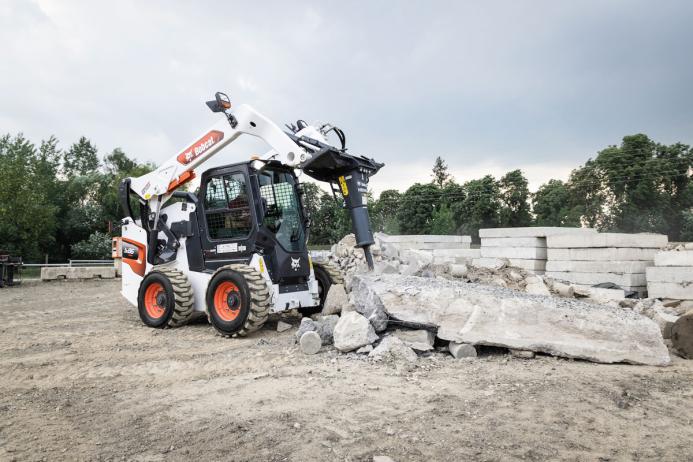
First published in the October 2024 issue of Quarry Management
An insight into Bobcat’s ever-expanding range of machines and attachments, and their applications
Bobcat are dedicated to enabling their customers to carry out all their work quickly and efficiently, which is why they offer not only an ever-growing selection of compact machines, all of which are intended as tool carriers, but also an extensive and continuously developing range of attachments to be used on these machines.
The power available, coupling systems, hydraulics, and the Attachment Control Device (ACD) on Bobcat machines are all designed to facilitate the quick change of attachments and to allow customers to perform a wide range of tasks with the same machine. Working with attachments is an attractive choice from an investment point of view, say Bobcat, especially for multidisciplinary companies.
‘We supply one of the most extensive programmes of attachments, with which you can carry out all common activities in construction, landscaping, agriculture, demolition, recycling, and material handling. That is why all our compact machines have been developed as tool carriers,’ explained Katinka Kincses, product manager for attachments at Bobcat EMEA.
‘Yet it is important to choose the right products from Bobcat. For example, a skid-steer loader is strong and agile, but for use on sensitive terrain where you do not want to disturb the soil too much, it is better to use a compact track loader. Power also plays a role. If you want to use a forestry mulcher, a wheel saw or a snow plough, you will need to purchase a heavy-duty machine. If you want to work at a high driving speed, a skid-steer loader is not suitable, and it is better to use a compact wheel loader. If lifting height and reach are important, a compact wheel loader or a telehandler are the more obvious choices. Compact wheel loaders also have the advantage that the driver sits higher and has a better view of the work area.’
Ms Kincses believes that a customer should only purchase a specialist machine if they do the same, specialist work all day long. ‘For golf course maintenance, a ride-on mower from Bobcat is a great investment, but in most other cases a multi-purpose tool carrier is a wiser investment, because you can carry out more work and projects, work all year round and, therefore, use the machine more intensively. You often see that a new customer buys a machine with three or four attachments and gradually adds another three or four attachments, so that they can do as much work as possible with the same machine.’
Once customers have made their choice of machine, they can choose from more than 120 attachments on offer from Bobcat, many of which are compatible with different Bobcat tool carriers. For convenience, Bobcat have subdivided the attachments based on activity: including demolition, construction, roadworks, landscaping, forestry, agriculture, and material handling.
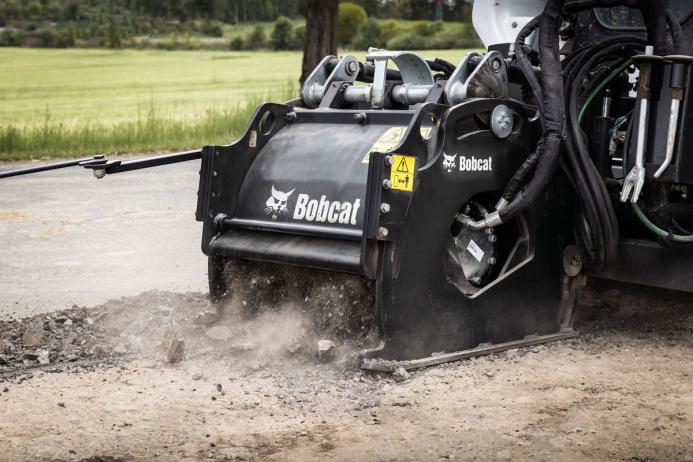
The range is particularly wide, especially for landscaping and road construction, but many attachments can be used for general work: such as buckets, grabs, clamps, pallet forks, roller brushes, dozer blades, graders, rakes, flail mowers, trenchers, drills, and demolition hammers. In addition, there are specialist attachments such as vibrating rollers, concrete mixers, concrete buckets, planers, high-pressure water cleaners, work platforms, woodchippers, and even a tree transplanter.
Bobcat have integrated a lot of functionality into the machines and attachments to enhance their connectivity and operation. The company’s Bob-Tach system for connecting attachments is the industry standard, but since the early 2000s the Power Bob-Tach system has also been available, which allows the operator to connect and disconnect non-hydraulic attachments without the need to leave the cab. Another useful feature is the speed-management system, which allows adjustment of the travel speed independently from the engine speed, allowing for higher productivity.
The Attachment Control Device built into the attachment is a CANbus system that controls the communication between the machine and the attachment. Thanks to the ACD, the machine recognizes the attachment and automatically adjusts the settings of, among other things, the joystick controls and the hydraulics.
The driver can adjust the settings on the display in the machine and receive an overview of the operating hours, performance, and status of the attachment. If an operator uses remote control to work their machine, all functions for controlling the attachment are also automatically available.
Katinka Kincses advises customers to use Bobcat attachments on their Bobcat carriers: ‘Our machines and attachments are optimally matched and tested. For example, you can be sure that the attachment’s software is always up to date and functions work optimally through controls available in the cab, that the hydraulic system is suitable for its tasks, and that you can use all functions of the attachment. If there are technical problems, Bobcat can solve them within the warranty period, and you are not stuck between two suppliers pointing fingers at each other.
As attachments product manager, Ms Kincses is responsible for product development, marketing, additional services, and training.
‘I view my department as the voice of the customer. We map out their wishes and conduct field research to develop new attachments and new functions,’ she explained. ‘And while I don’t want to say too much now about the latest attachment launches planned by Bobcat, we are working on interesting things that will see the light of day next year,’ she confirmed.

New Stage V Bobcat S630 and S650 skid-steer loaders
Bobcat have launched new Stage V versions of the company’s M-Series S630 and S650 skid-steer loaders, designed for use in higher-regulated markets in Europe. Customers now have a wider selection in this size of machine, with a choice between the new M-Series S630/S650 models and the more advanced R-Series S66/S76 machines.
The new S630 radius lift path loader combines excellent manoeuvrability in tight areas with the reach and visibility needed for applications such as dumping materials over walls, backfilling, or loading flatbed trucks. The S630 has a rated operating capacity of 1,012kg and a tipping load of 2,023kg.
The S650 model features vertical lift path boom arms particularly suited to lift and carry as well as material-handling applications. The S650 has a rated operating capacity of 1,227kg and a tipping load of 2,455kg. Both models continue to offer excellent versatility through compatibility with a very wide range of Bobcat attachments.
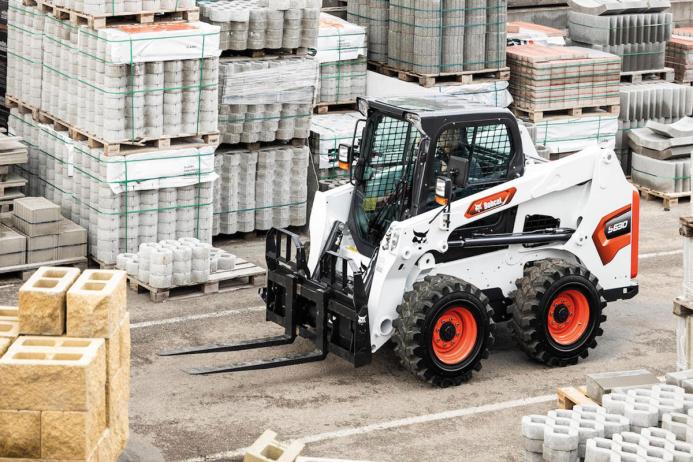
Delivering superior performance while adhering to strict Stage V emission regulations, both the S630 and S650 are powered by the well-proven Bobcat D24 engine featuring a Bosch fuel-injection system. With the engine situated transversally in the S630/S650, these models have maintained their compact size, allowing the machines to operate and turn in the same tight spaces.
New engine technology has resulted in lower fuel consumption for the same type of work, whilst the first engine oil service interval has also been extended to 500h and improved fuel filtration means less frequent filter replacements. The S630/S650 are also equipped with versatile-duty tyres as standard. These have a bi-directional design for most common mixed surfaces, which again reduces costs by improving tyre lifetime significantly.
The base S630/S650 models are equipped with a new deluxe control panel offering a selection of most European languages. The deluxe panel reduces the risk of misuse, thanks to the keyless start function, whilst options such as High Flow or 2-Speed can also be locked, if necessary, and protected by passwords. Every machine is also equipped with Bobcat telematics solutions.
New after-treatment technology (DPF) works automatically without any interaction during normal operation. If necessary, this technology can be easily managed from the menu in the deluxe panel, which allows the operator to monitor the machine and exhaust after-treatment. The new automatic multi-step engine low-idle sequence in cold conditions further improves engine performance.
As well as the deluxe panel, Bobcat telematics, and versatile-duty tyres, standard features on the S630/S650 include hand and foot controls, a deluxe cab with side windows, and a suspension seat. Options include a cloth suspension seat, selectable joystick controls (SJC), a deluxe cab with heating or HVAC, heavy-duty offset and severe-duty tyres, and Power Bob-tach.
On machines equipped with selectable joystick controls (SJC), the auto-idle feature reduces the engine speed to low idle when the joysticks are in neutral position and have not been used for about five seconds. Auto-idle allows for quieter overall operation and reduced fuel consumption.
The standard warranty on the S630/S650 has been extended to two years (2,000h), with Protection Plus providing up to five years of coverage.
Subscribe to Quarry Management, the monthly journal for the mineral products industry, to read articles before they appear on Agg-Net.com



